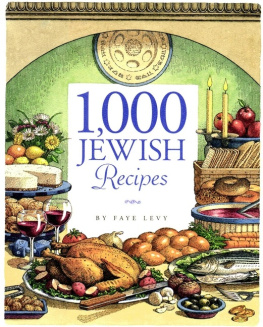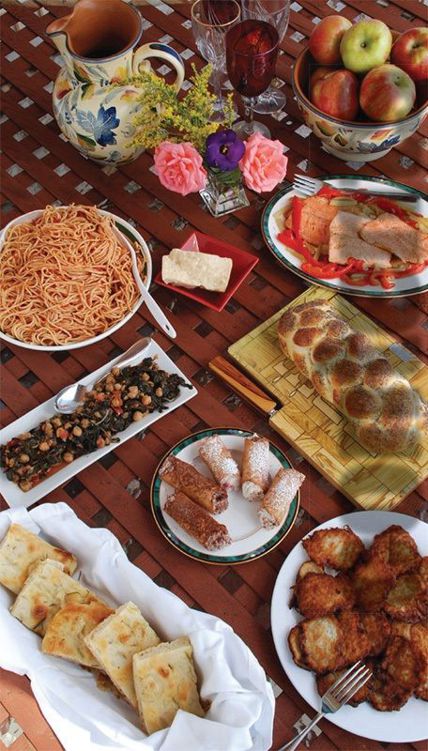Text, Recipes, and Photography by Marcia A. Friedman
Copyright 2013 by Marcia A. Friedman
All rights reserved. No part of this book may be reproduced or distributed in any form or by any means without written permission from the publisher.
Digital book(s) (epub and mobi) produced by Booknook.biz.
Introduction
Sometimes food is more than just something to eat. For me, anyway, it is also memories, culture, bonds, creativity, and connections. I think thats why I gravitated to getting to know Jewish food when I converted to Judaism more than 15 years ago. Making and enjoying the food and sharing it with others seemed like a touchstone for a new people and culture.
As I started exploring Jewish foods, though, my love of the meatballs and lasagna I grew up with kept tugging on my apron strings, returning me to my Italian heritage. As I was bringing something new to the table, the old called out to be revisited and explored beyond the beloved greatest hits of my well-assimilated Italian side. I had to take measure of that. And so I had myself a projectto build a repertoire of Jewish and Italian recipes, but Italian recipes that work in a kosher context (no small undertaking given all the rules).
Where to begin? How about the Jewish recipes of Ashkenazi (Eastern European) origin? Thats where my future husbands family hailed from, and I was already familiar with these Jewish deli stand-bys such as latkes, matzah balls, and brisket. And while the recipe versions themselves interested me, so did the surrounding stories and arguments about the density of matzah balls, for example, or the variations on latkes and fried matzah. Who knew? Meanwhile, I delved into the volumes written on Italian food. From there, it didnt take long to uncover several collections of recipes passed down from Italys small but vibrant Jewish communityan unexpected jackpot of ideas bridging the cultures and blazing a trail for Italian dishes adjusted to kosher rules. And then there was the natural trans-Mediterranean connection of Italy and the Jewish homeland of Israel, providing a whole other source of recipe ideas. Plus, I quickly learned that Jewish and Italian cuisines share some versions of essentially the same foodslike blintzes and crespelle, kreplach and ravioli, and Mandelbrot and biscotti.
Before I knew it, I became the kid in the candy store, delighted, slightly overwhelmed, and ready to indulge in all the possibilities. Time to start picking and choosing, cooking and testing. I wanted dishes for the Jewish holidays, family get-togethers, parties, and everyday meals. That meant classics from both traditions, recipes that incorporated features of both, and my own special creations that connected through history, ingredients, people, or in other ways big or small, to Italian, Jewish, or Mediterranean cuisine. As a home cook, all around I looked for appealing recipes and preparations that could be made in a regular kitchen and for a variety of tastesand, of course, could be made kosher.*
Wanting each recipe to be sensational, successful, and something that I would want to make over and over again, I tested and re-tested. Recipes werent done until I liked the results. This took a very long time, but produced recipes that have become some of my most treasured and requested, and anyone can enjoy them. I feel so possessive of them that I almost hesitate to give them out. Almost. This labor of love was to create a unique collection for me, but also to share.
Beyond the cooking and eating, this whole adventure with Jewish and Italian food bubbled over throughout with memories and meaningabout people, stories, culture, tradition, and how I related to it all. And so each chapter offers an essay highlighting a point or two on my cultural-culinary journey. Although not chronological and not essential to appreciating the recipes, these vignettes are best read in sequence. But as an avid cookbook reader myself, I know part of the fun is jumping in with whatever captures your interest mostand feel free to do that here.
So then, welcome to my Jewish-Italian kitchen. I truly hope that you enjoy these recipes and that at least some become favorites. In Italian, Yiddish, and HebrewBuon appetito, est gezunterhayt, and beteavon!
*To help with kosher cooking, recipes are marked as dairy, meat, or pareve (neutral, neither meat nor dairy). For more on kosher requirements, see .

Chapter 1: Soups and Stews
Reflections
Recipes
Come on in! If a food could hang a welcome sign on itself, soup would do it. Its roles as starter courses and comfort foods, and its ability to feed a crowd (especially the stews), make this group of recipes a friendly lot. At the heart is chicken soup, long in the first-aid arsenal of Jewish mothers and caretakers everywhere and a building block of many recipesJewish, Italian, or otherwise. My title recipe, meatball matzah balls, appears in this chapter, as do adaptations of such traditional stews as beef stew, sauerkraut, and chili. The chapter also includes the Jewish specialty matzah ball soup and the Italian vegetable soup minestrone. It also features one of my all-time favorites, a savory butternut squash soup sprinkled with toasted seeds.

Scattered Seeds
My mom Sandra loved to try new recipes. One day she stood at the kitchen counter where she always worked and unfolded a piece of paper with handwritten instructions. She moved about the long narrow kitchen, gathering flour, salt, eggs, a packet of yeast, her well-worn wooden board, and her favorite slate blue glass mixing bowl. I stood at the counter, my nose and eyes a good height to observe her latest culinary adventure.
Soon my mom turned out a plump warm dough on her wooden board and began kneading. Even as an elementary school kid, I loved watching her and helping, and she encouraged my brother and me to become comfortable with food and cooking. She sent us to the backyard garden to pick the ripest tomatoes and pull spring onions from the earth. She stood back and let me experiment with my first original recipe, a beef noodle soup made with bouillon, wide egg noodles, and a bit too much black pepper. When it came to making meatballs for spaghetti sauce, she taught me how to mix the ingredients and roll the balls. As she worked on her bread, she turned the dough over to me to let me wrestle with it a few minutes, pushing and pressing and pulling to activate the yeast before setting the dough aside to rise.


















